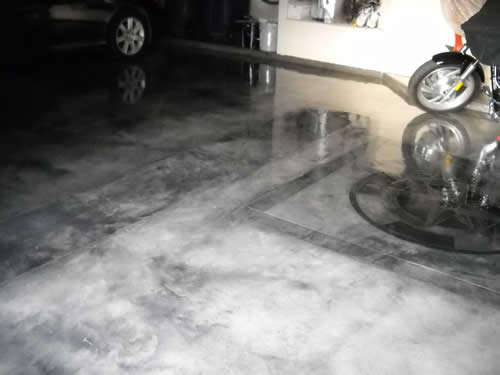

Read
ABOUT US
View
PHOTO GALLERY
| INTERIOR FLOORS ACID STAINS CONCRETE OVERLAYS DYES & WATERBASED STAIN STENCILING & SANDBLASTING SELF-LEVELING POLISHED CONCRETE |
| EXTERIOR FLOORS STAMPED CONCRETE STAMPED OVERLAYS CONCRETE RESURFACING RECONSTRUCTED STONE |
| INDUSTRIAL COATINGS POLYASPARTIC EPOXIES GARAGE FLOOR COATINGS |
 |
|
What are Polyaspartic Coatings?
A Polyaspartic is a type of polyurea which was developed back in the early 80's and used for corrosive resistant coatings and repair materials. They are a two-part system meaning that a resin has to be mixed with a catalyst to create the curing reaction that hardens the material. The draw back of polyureas is the short pot-life. Polyurea dries in 5-10 seconds requiring plural component spray equipment which is costly and cumbersome. Polyaspartics Aliphatic Polyurea (PATs) overcome all this but still retain the high strength and other advantages of polyurea. The chemistry of polyaspartic coatings is based on the reaction of an aliphatic polyisocyanate and a polyaspartic ester, which is an aliphatic diamine. Polyaspartic coating technology has concentrated on achieving low or near-zero VOC coatings where the polyaspartic is the main component of the co-reactant for reaction with a polyisocyanate. The unique adjustable reactivity of the polyaspartic esters allows for the design of fast-curing coating tailored to the needs of the application. The fast curing feature of these coatings provide faster applications, along with high-build, low-temperature curing, and abrasion and corrosion resistance. The term polyaspartics came about to differentiate it from polyureas and polyurethanes.
|
|
Polyaspartics for FloorsPolyaspartics are a great coating for a high traffic, commercial application because of their superior abrasion resistance and fast cure time. Learn More> |
Polyaspartic Garage Floor CoatingsBecause of their resistance to hot tire marks, polyaspartics make a great garage floor coating. Learn More> |
Advantages of Polyaspartic CoatingsThe advantages of polyaspartic coatings include superior strength, UV protection, high gloss, and zero VOCs. Learn More> |
214-960-9600
